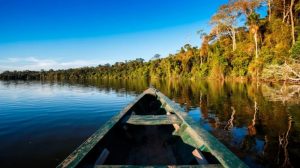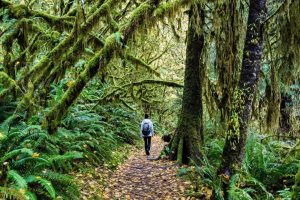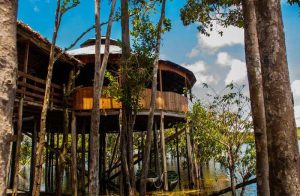
Embark on a journey through the lush rainforest with essential survival tips for travelers, covering everything from packing the right gear to navigating through dense foliage. Get ready for an adventure like no other!
Are you prepared to brave the wild and unpredictable rainforest? Let’s dive into the must-know tips to ensure a safe and memorable journey.
Rainforest Survival Tips for Travelers
When venturing into the rainforest, it is crucial to be well-prepared to ensure your safety and comfort. Here are some essential tips to keep in mind:
Essential Items to Pack
- Lightweight, quick-drying clothing to stay comfortable and protect against insects.
- Insect repellent to ward off mosquitoes and other bugs.
- A sturdy pair of hiking boots with good traction to navigate through muddy terrain.
- A first aid kit with essentials like bandages, antiseptic wipes, and any necessary medications.
- A reliable flashlight and extra batteries for navigating in low-light conditions.
Proper Clothing for Rainforest Survival
Wearing the right clothing in the rainforest can make a significant difference in your comfort and safety. Opt for lightweight, moisture-wicking fabrics that dry quickly to prevent chafing and discomfort. Long sleeves and pants are essential to protect against insect bites and scratches from vegetation. Additionally, a wide-brimmed hat and sunglasses can shield you from the sun’s rays.
Navigation Tools in the Rainforest
- A high-quality compass to help you stay oriented in the dense vegetation of the rainforest.
- A detailed map of the area you are exploring, preferably waterproof to withstand the elements.
- A GPS device or smartphone with offline maps as a backup navigation tool.
Clean Water Sources and Purification Methods
Access to clean water is crucial for survival in the rainforest. Be sure to carry a reliable water filtration system or purification tablets to make water from streams or rivers safe to drink. Avoid drinking directly from natural water sources without proper treatment to prevent waterborne illnesses.Remember, being well-prepared and informed is key to a successful rainforest adventure. Stay safe and enjoy the wonders of nature!
Mountain Travel

When it comes to mountain travel, survival tips differ from those needed in the rainforest. The mountain environment presents its own set of challenges that travelers must be prepared for. From extreme weather conditions to high altitudes, being equipped with the right knowledge and gear is crucial for a safe journey.
Gear Required for Mountain Travel Survival
In mountainous regions, it is essential to have the right gear to ensure your safety and well-being. Some key items to pack include:
- Insulated clothing to protect against cold temperatures
- Sturdy hiking boots for rough terrain
- A reliable tent for shelter
- Sleeping bag rated for low temperatures
- Navigational tools like a map and compass
- Emergency supplies such as a first aid kit, whistle, and flashlight
Altitude Sickness Prevention and Management
Altitude sickness, also known as acute mountain sickness, can occur when traveling to high altitudes where the air pressure is lower. To prevent or manage altitude sickness, consider the following tips:
- Acclimate slowly by gradually ascending to higher altitudes
- Stay hydrated by drinking plenty of water
- Avoid alcohol and smoking, as they can worsen symptoms
- Consider taking medication like acetazolamide as a preventive measure
- If symptoms worsen, descend to a lower altitude immediately
Importance of Shelter and Warmth in Mountain Environments
In mountain environments, having proper shelter and staying warm are critical for survival. Exposure to cold temperatures can lead to hypothermia, a dangerous condition that occurs when the body loses heat faster than it can produce. To stay safe in mountain environments, prioritize the following:
- Build a shelter using available materials to protect against wind and precipitation
- Wear layers of clothing to trap heat close to the body
- Keep dry to prevent heat loss through evaporation
- Carry a reliable fire starter to create warmth when needed
Desert Travel

When it comes to desert travel, survival tips differ significantly from those needed in the rainforest. The arid environment of the desert presents unique challenges that travelers must be prepared to face. Let’s explore the essential items needed for desert survival, water conservation strategies, and the importance of protecting oneself from extreme heat and sun exposure.
Essential Items for Desert Survival
- Water: The most crucial item for desert survival. Carry enough water to stay hydrated throughout your journey.
- Food: Pack non-perishable, high-energy snacks to keep your energy levels up.
- Navigation tools: A map, compass, or GPS device to avoid getting lost in the vast desert.
- Shelter: Lightweight, portable shelter to protect yourself from extreme temperatures and harsh weather conditions.
- First aid kit: Essential for treating minor injuries or illnesses that may occur during your travels.
Water Conservation Strategies in the Desert
- Drink small sips of water frequently rather than gulping it all at once to conserve water.
- Avoid strenuous activities during the hottest parts of the day to minimize sweating and water loss.
- Look for natural sources of water like springs or cacti that can be used for hydration in emergencies.
- Consider using a portable water filtration system to purify water from questionable sources.
Protecting Oneself from Extreme Heat and Sun Exposure
- Wear loose, light-colored clothing to reflect sunlight and keep your body cool.
- Use a wide-brimmed hat and sunglasses to shield your face and eyes from the sun’s harmful rays.
- Apply sunscreen with a high SPF to protect your skin from sunburn and potential long-term damage.
- Take frequent breaks in shaded areas to prevent overheating and dehydration.
Arctic & Polar Travel
When traveling to arctic and polar regions, adventurers face unique challenges due to extreme cold temperatures and harsh conditions. Proper preparation and essential gear are crucial for survival in these unforgiving environments.
Essential Gear and Clothing
In order to stay warm and protect yourself from the cold, it is essential to wear multiple layers of clothing made from materials that provide insulation and moisture-wicking properties. Items such as thermal base layers, fleece jackets, waterproof outer shells, insulated boots, gloves, and hats are essential to keep your body heat in and the cold out.
Staying Warm and Avoiding Hypothermia
To prevent hypothermia, it is important to stay dry and avoid sweating by regulating your body temperature through layering and adjusting clothing as needed. Carry extra dry clothing in case you get wet, and seek shelter from wind and moisture to retain body heat. Always keep moving to maintain circulation and warmth.
Importance of Food and Calorie Intake
In polar travel, where the body burns more calories to stay warm, it is crucial to consume high-energy foods that provide essential nutrients and fuel for your journey. Pack lightweight, high-calorie snacks like nuts, dried fruits, energy bars, and dehydrated meals to sustain your energy levels throughout your expedition.
Jungle & Rainforest Travel
When traveling to jungle and rainforest environments, it is crucial to be aware of the specific dangers that can be encountered in these dense and diverse ecosystems. From wildlife encounters to insect-borne diseases, being prepared and taking necessary precautions is essential for a safe and enjoyable trip.
Wildlife Encounters and Safety Precautions
In jungle and rainforest areas, travelers may come across a variety of wildlife, including snakes, spiders, and large mammals. It is important to keep a safe distance and avoid provoking or approaching any wild animals. Be sure to research the common species in the area you are visiting and learn how to react in case of an encounter. Additionally, always carry a first aid kit with supplies for treating insect bites and stings.
Importance of Insect Protection and Disease Prevention
Insects in the jungle can carry diseases such as malaria, dengue fever, and yellow fever. To protect yourself, wear long sleeves and pants, use insect repellent containing DEET, and sleep in mosquito nets. It is also recommended to take antimalarial medication before and during your trip, as prescribed by a healthcare professional.
Tips for Setting Up Camp and Staying Safe
When setting up camp in the jungle, choose a dry and elevated location away from water sources to avoid flooding and minimize the risk of encountering dangerous wildlife. Always store food securely to prevent attracting animals, and be mindful of your surroundings at all times. It is also important to properly dispose of waste and avoid leaving any trace of your presence in the delicate rainforest ecosystem.
Coastal & Beach Travel
When traveling to coastal and beach destinations, it is essential to prioritize safety measures to ensure a smooth and enjoyable experience. From water safety to sun protection, being prepared can make a significant difference in your trip.
Exploring the coast comes with its unique set of challenges and hazards, making it crucial to be aware of your surroundings and take necessary precautions. Here are some tips to help you stay safe and make the most of your coastal and beach travel:
Water Safety and Potential Hazards
- Always swim in designated areas with lifeguards present to ensure your safety.
- Be cautious of rip currents, which can quickly pull swimmers away from the shore. If caught in a rip current, swim parallel to the shore until you break free.
- Watch out for marine life such as jellyfish, sharks, and stingrays. Avoid swimming near fishing piers or where fish are being cleaned.
- Stay hydrated and avoid excessive alcohol consumption while in the water to prevent accidents and dehydration.
Dealing with Tides, Currents, and Marine Life
- Check tide schedules before heading to the beach to avoid getting caught in rising tides or strong currents.
- If you encounter a strong current while swimming, do not panic and try to swim against it. Instead, swim parallel to the shore to escape its pull.
- Respect marine life and avoid touching or disturbing animals in their natural habitat. Be cautious of sharp coral reefs and rocks while swimming or snorkeling.
Sun Protection and Hydration
- Apply sunscreen with a high SPF regularly, especially after swimming or sweating, to protect your skin from harmful UV rays.
- Wear protective clothing, such as a hat and sunglasses, to shield yourself from the sun’s intense rays.
- Stay hydrated by drinking plenty of water throughout the day, especially in hot and sunny beach conditions. Avoid sugary drinks and opt for water to stay properly hydrated.
Closure
As you wrap up your rainforest survival guide, remember to stay equipped, informed, and always ready for the unexpected. With these tips in mind, you’re well on your way to conquering the wonders of the rainforest!
FAQ Insights
What are the key items to pack for rainforest travel?
Pack lightweight, moisture-wicking clothing, insect repellent, a first aid kit, a water purification system, and a reliable navigation tool.
How important is proper clothing for rainforest survival?
Proper clothing is crucial for protection against elements, insects, and potential hazards in the rainforest. Opt for breathable fabrics and sturdy footwear.
Why is clean water essential in the rainforest?
Clean water is vital for hydration and to prevent waterborne illnesses. Always carry a reliable water purification method to stay safe.
What’s the significance of navigation tools in the rainforest?
Navigation tools help you stay on course, avoid getting lost, and find your way back to safety in the dense rainforest environment.





